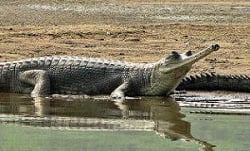Blueprint To Boost Gharial Population In Odisha’s Satkosia Gorge

Bhubaneswar: Concerned over the alarming fall in the number of gharials (fish-eating crocodiles) in Satkosia gorge, the 21-km narrow stretch of River Mahanadi near Tikarpada, about 60 km from Angul district, the authorities of Satkosia Wildlife Division and Nandanakan Zoo have prepared a blueprint to increase their population.
Jayant Das, the deputy director of Nandankanan Zoo, informed that about 30 sub-adult gharials will be released in Satkosia gorge in a phased manner. “As the number of gharials at Nandankanan has gone up more than its capacity, the zoo authorities have stopped their artificial incubation since 2015. Looking at their excess numbers at the zoo, the forest department has decided to release them in Satkosia gorge, which is an ideal habitat for them, to increase their population,” he added.
At present, there is only one old gharial left in Satkosia gorge.
Das further said that some young gharials from Nandankanan were released in Satkosia gorge in the recent past. But their numbers did not grow because there was no breeding.
The zoo official blamed the dwindling gharial population in Satkosia gorge on increasing human activities in the river and the consequent reduction in habitable stretches for the gharials. Besides, the survival rate of crocodile hatchlings in nature is very low due to predators.
Notably, the three species of crocodiles (gharial, mugger and saltwater crocodile) in the river systems of Odisha have been on the verge of extinction since the 1970s.

Consequently, piecemeal efforts were made to save these crocodile species. Dr HR Bustard, an expert of the Food and Agriculture Organisation (FAO) engaged by UNDP/FAO and the Indian government, studied the prospects of crocodile rehabilitation. On the basis of his report and recommendations, a Crocodile Conservation Project was launched in 1975 in different states.
The gharial and saltwater crocodile conservation programme was first implemented in Odisha in early 1975. Subsequently, the mugger conservation programme was initiated in the state. The funds and technical support for the projects came from UNDP/ FAO through the Central government.
At present, gharial and saltwater crocodile breeding centres are functioning at Tikarpada in Angul district and Dangamal in Bhitarkanika National Park in Kendrapara district.
One of the longest of all living crocodiles, the male gharial has a body length of up to 6 metres (20 ft). With 110 sharp, interdigitated teeth in its long, thin snout, the gharial is well adapted to catching fish, its main diet. The tail is well-developed and laterally flattened. Together with webbed feet, it provides tremendous manoeuvrability in deep water.
A study on the fossils of this species excavated in Pliocene deposits in Sivalik Hills and Narmada River valley revealed that the gharial probably evolved 42 million years ago.

Comments are closed.